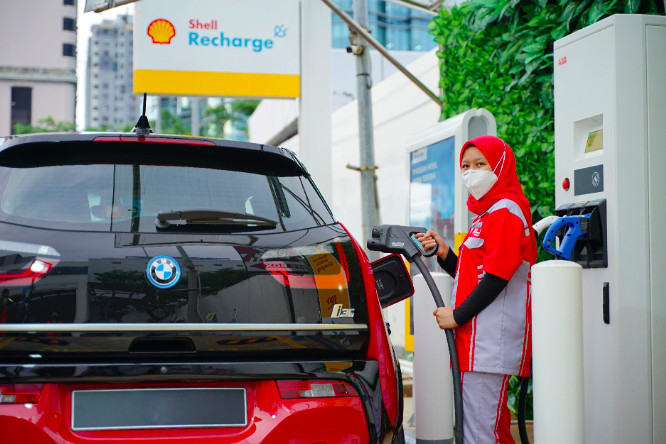Electric vehicles offer chance to clean up our cities
E-mobility initiatives should focus on large fleets of high mileage commercial vehicles, including buses, taxis, and delivery trucks.
Change Size

T
he coronavirus disease (COVID-19) pandemic has reshaped urban transport across Asia and the Pacific. In the wake of the virus, many Asian cities banned or severely restricted public transport usage, forcing travelers to switch to alternative non-motorized or private forms of transport. Shops closed down for months, resulting in a massive increase in e-commerce and growth in light good vehicles to make deliveries.
As cities start to open up, the time is ripe for a modernization program focusing on clean public transport and light duty delivery vehicles. Failure to do so will result in a bigger pollution and congestion mess than before the pandemic.
Asia’s motor vehicle fleets have been doubling in size every 5-7 years. Aside from congestion problems, which can cost an economy around 2 percent-5 percent of gross domestic product (GDP) annually, motor vehicles are responsible for up to 80 percent of air pollution in urban Asia.
Further, vehicular emissions contributed to 23 percent of greenhouse gas (GHG) emissions in 2009, compared to 41 percent from the energy sector. If nothing changes, this figure is expected to surge to 46 percent in 2035, and it could even hit 80 percent by 2050, according to Asian Development Bank estimates.
To address this, switching from combustion engine vehicles to electric vehicles (EVs) has emerged as a promising approach for Asian megacities.
In its recent publication “E-Mobility Options for ADB Developing Member Countries,” ADB underlined options to fully harness the EV momentum. The report notes significant progress in the People’s Republic of China (PRC) in the last decade, affirming that the viability of electric transport is no longer in doubt for Asia. More importantly, it recommends a three-pronged strategy to pursue e-mobility.
First, e-mobility initiatives should focus on large fleets of high mileage commercial vehicles, including buses, taxis, and delivery trucks. Priority should be given where EV investments yield the highest economic and environmental returns. Large fleets of high-mileage vehicles that operate in cities allow quicker repayment of higher upfront fixed-costs.
Jakarta is one city taking a coherent and concerted effort to decarbonize its transport system and achieve the benefits of improved air quality at the same time. The Indonesian capital is already on the right path with fast tracking the operation of 100 e-buses on the TransJakarta bus network as part of the capital’s clean air initiative. Replacing a diesel bus with an electric unit in Jakarta has the same environmental impact as electrifying 40 fossil fuel cars or 110 motorcycles.
The city is looking to run a fully electric bus system of more than 14,000 e-buses by 2030. Meanwhile, the taxi company BlueBird launched a trial fleet of 30 e-taxis in May 2019 and state land transportation company DAMRI, which runs the airport bus service, is planning to phase-in 50 electric units with ADB support as well.
Bangkok is also looking at decarbonizing its transport sector, including innovative e-mobility solutions such as e-ferries. ADB estimates that replacing fossil fuel vehicles with EVs in Bangkok can result in 50 percent-70 percent lower Well-to-Wheel GHG emissions for the city.
Second, cost-effective EV initiatives need to be preceded by putting in place a supporting ecosystem with adequate power infrastructure. Adequate electricity supply and tailoring the charging facilities to different vehicles are central to the EV ecosystem. For example, with fast-charging along service routes, e-buses can run with smaller battery packs and shorter charging time.
One potential source of additional revenue is the refurbishment of EV batteries. Renewable sources such as solar and wind energy, which depend on sunlight and weather conditions, generate power during times that do not always match with usage.
As such, battery packs can be refurbished to store renewable energy once they are no longer useful in electrical vehicles; enabling larger integration of carbon-free solar and wind power into our grids. This tackles environmental anxiety over battery waste and extends batteries’ economic usefulness, potentially defraying investment burden.
Lastly, EV uptake depends on the levels of fossil fuel prices and incentives; financial or otherwise. Incentives should be targeted toward high impact vehicles in support of sustainable business models. For example, the PRC accounts for more than 95 percent of e-buses operating worldwide and, on average, subsidizes 65 percent of the purchase cost to close the price differentials against diesel alternatives. Public charging infrastructure can also be subsidized in places with high visibility such as urban centers.
Some cities have been offering non-financial incentives for EVs such as priority parking at charging spots, priority lanes, and in some places; exclusive access. For example, London exempts EVs from congestion charging. Many European cities including Paris, Rome, and Madrid have also announced plans to ban diesel vehicles. These incentives, however, must come with a carefully thought-out time limit as these might skew travel behavior and congest highways with private EVs.
Despite the impetus for e-mobility, getting started can still be a challenge for Asian megacities. Recent strides in battery technologies are tipping e-mobility in our favor. Yet fleet managers hesitate to switch to EVs when charging facilities do not meet operational requirements.
Likewise, utility companies are reluctant to expand charging infrastructures when demand is uncertain. Cities in the PRC solved this problem by electrifying public fleets, namely buses and sanitation trucks, in the early stages. Today, EV sales in the PRC have surged and no longer rely on government purchases.
For developing Asia, the economics show that the opportunity is there to make a clean start after COVID-19. Cities must make the switch to e-mobility and get the most out of the emerging revolution.
***
The writer is vice president of knowledge management and sustainable development at the Asian Development Bank.









